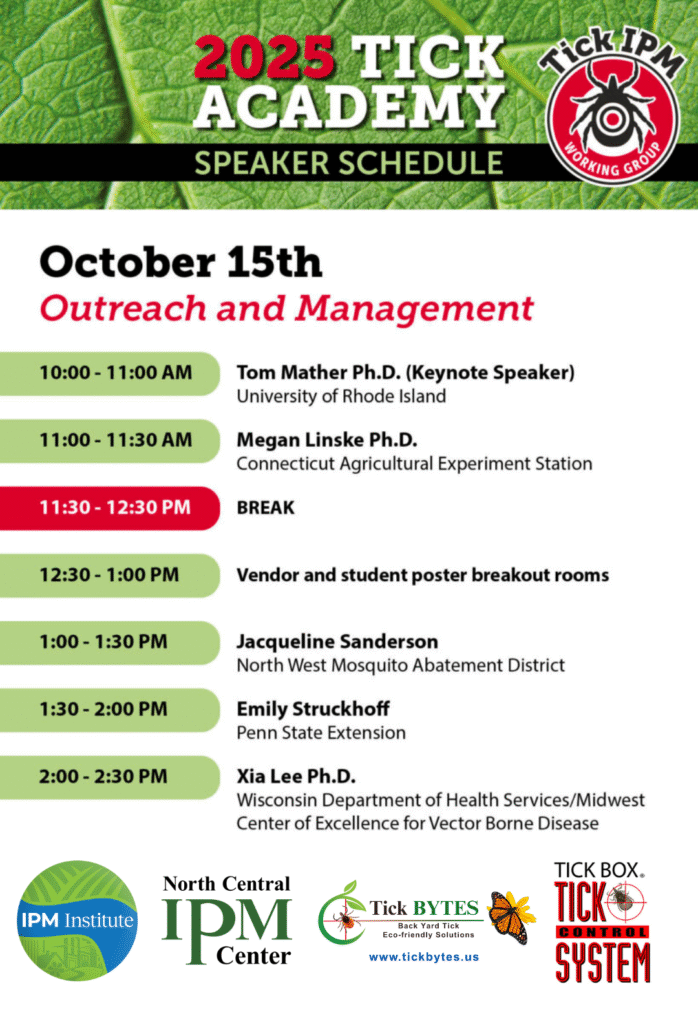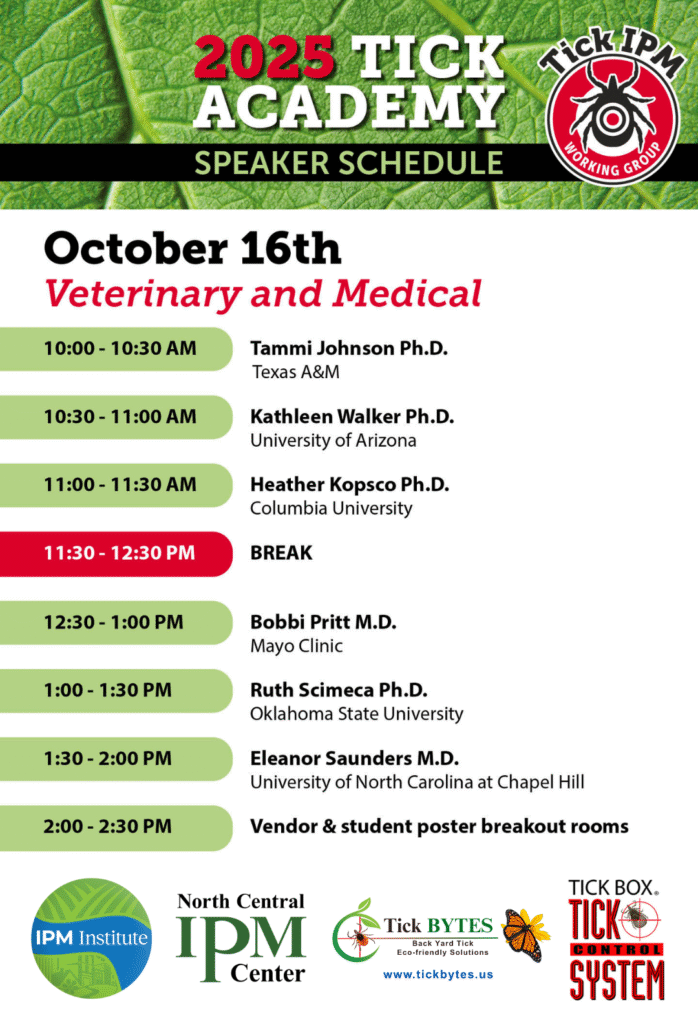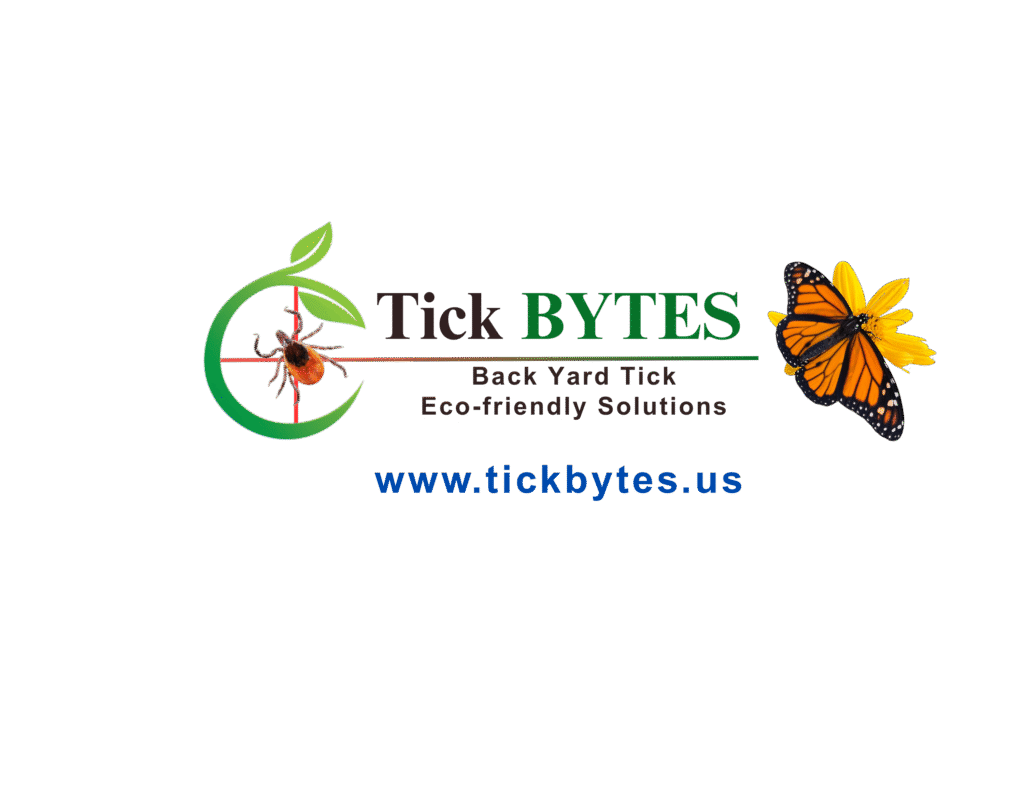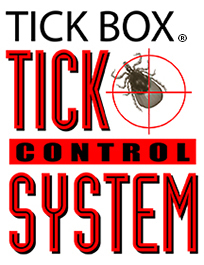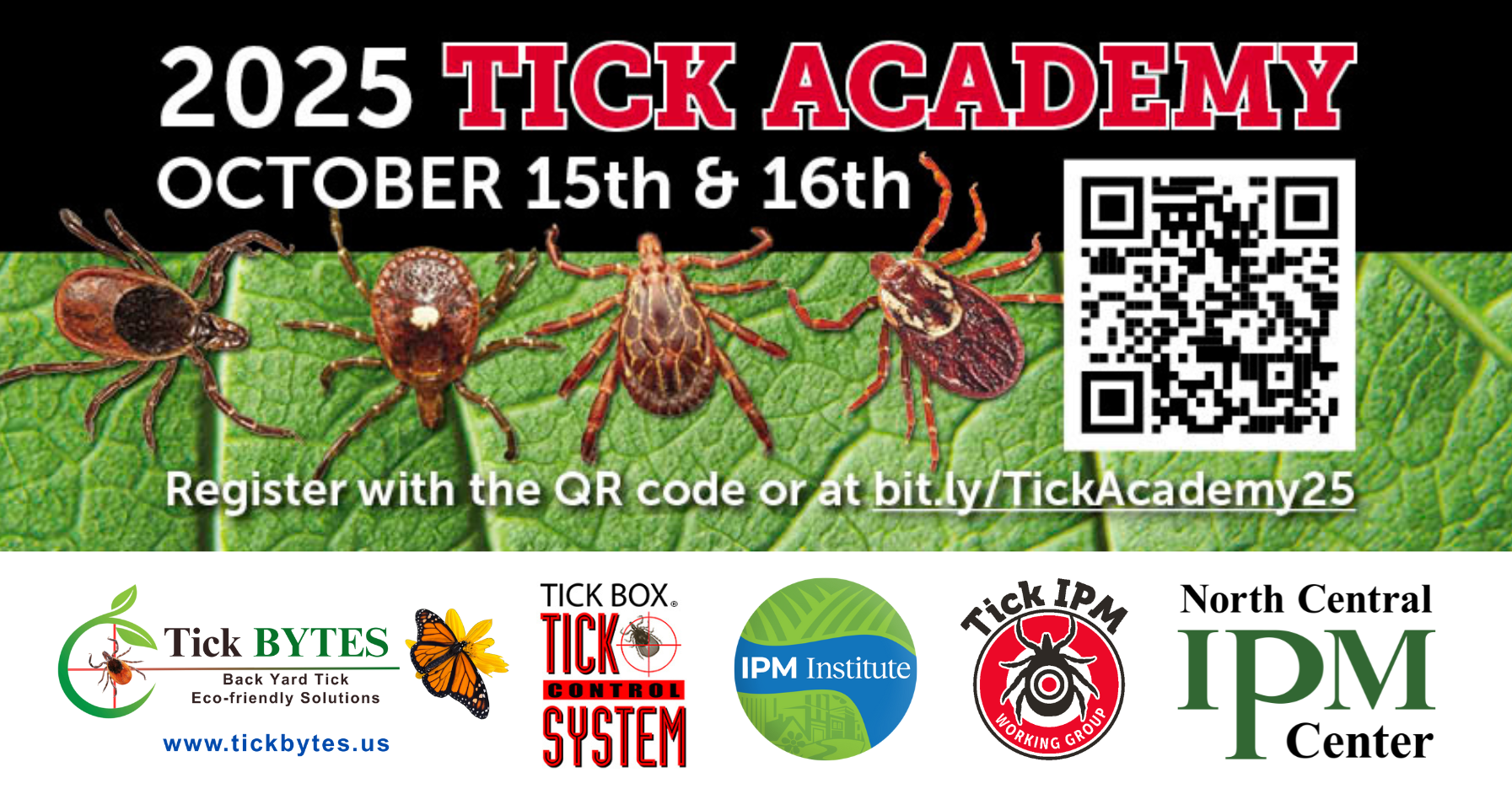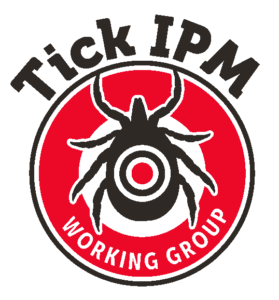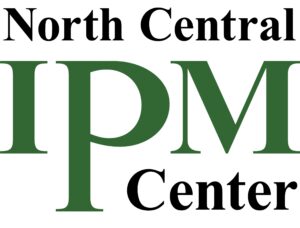Tom Mather, Ph.D. (Keynote)
Title: Just-In-Time Learning Tools for Tick-bite Prevention Education
Abstract:
Currently, most tick-bite prevention education uses a “just-in-case” pedagogy – distributing brochures, community talks, social media – information delivered but not necessarily when it can or will be acted upon right away. What if more learning opportunities could anticipate, tailor, and deliver best practice information when people need to know it? This presentation will describe several “just-in-time” learning tools for disseminating tick-bite prevention information when people are more likely to practice it.
Megan Linske Ph.D.
Title: Optimizing Tick Control Timing: Fall Applications of Synthetic Pyrethroids for Pollinator-Friendly Residential IPM
Abstract:
Traditional spring applications of synthetic pyrethroids target residential tick populations but may coincide with peak pollinator activity, raising concerns about non-target impacts. This study evaluates the efficacy of fall, post-frost applications of lambda-cyhalothrin—using both liquid (Demand CS) and granular (Demand G) formulations—on overwintering Ixodes scapularis populations across 70 residential properties. Treatments were delivered via high-pressure sprayers and backpack blowers in spring-only, fall-only, and combined spring/fall regimens. Results show that fall-only applications, particularly high-pressure delivery of Demand CS, achieved 94–100% reductions in host-seeking adult ticks and eliminated nymphs the following spring. These findings suggest that fall treatments can effectively target multiple life stages of I. scapularis while reducing exposure risks for pollinators and other beneficial insects. This approach supports a strategic shift in tick management timing to improve both efficacy and environmental safety. Long-term monitoring is ongoing to assess pollinator impact, compare natural alternatives, and evaluate environmental residue.
Jacqueline Sanderson
Title: Tick Surveillance Programs and Integrated Tick Education in Community Outreach Programs
Abstract:
In 2025, legislation in Illinois expanded the authority of mosquito abatement districts to include tick surveillance and pathogen testing. In response, the Northwest Mosquito Abatement District (NWMAD) launched a tick surveillance program in fall 2024 and integrated tick education into its community outreach efforts. This program includes three major components: (1) systematic collection and identification of tick species across the district, (2) pathogen testing of specimens, and (3) public education on tick bite prevention and tick-borne disease risk.
We conducted tick drags along 24 frequently used Forest Preserve District trails, with transects of 750 or 1500 meters and collections every 10 meters. Sampling occurred in fall 2024 (October–November) and spring 2025 (April–June). Ticks were identified by species, sex, and life stage, then preserved in ethanol. All Ixodes scapularis specimens were submitted to the CDC Fort Collins laboratory for pathogen testing via Next Generation Sequencing.
In fall 2024, we collected 312 adult I. scapularis from 20 of the 24 sites. Of these, 136 (44%) tested positive for Borrelia burgdorferi sensu stricto, 12 (4%) for the human-active variant of Anaplasma phagocytophilum, and 8 (2.6%) for Borrelia miyamotoi. In spring 2025, we collected 348 I. scapularis, including 99 nymphs. Among these, 129 (37.1%) were positive for B. burgdorferi, 10 (2.9%) for B. miyamotoi, 12 (3.5%) for human-active A. phagocytophilum, and 4 (1.2%) for the non-human variant.
Community outreach efforts have included distribution of tick identification cards, educational materials on disease symptoms, demonstrations of tick checks, and interactive activities such as using a stuffed dog to teach proper tick removal. NWMAD has presented these programs at farmers markets, school and library events, and community festivals.
Our findings reveal unexpectedly high numbers of I. scapularis and notable pathogen prevalence in a region of the Midwest where tick presence has been underrecognized. Public engagement to date has highlighted a widespread lack of awareness about local tick populations, behaviors, habitats, and disease risks. Moving forward, NWMAD aims to partner with forest preserves to continue research on tick distribution and pathogen prevalence while expanding educational outreach to better equip the public with prevention knowledge.
Emily Struckhoff, MS
Title: Beyond bites: Leveraging extension to address tick-borne diseases and investigate attitudes and opinions towards a Lyme disease vaccine
Abstract:
With tick-borne disease cases increasing across the United States, new communication approaches are needed to connect with at-risk audiences and inspire action. Pennsylvania has some of the highest case numbers of Lyme disease in the United States, and the spread of tick species into the state in recent years has led to new disease and pest management concerns. To address these needs, in 2019 Penn State Extension founded the Vector-borne Disease Team, a new program to bring vector-borne disease education, outreach, and applied research across the state of Pennsylvania via the University’s cooperative extension system. Since the founding of this team, members have delivered presentations and workshops across Pennsylvania, developed educational initiatives, and authored a variety of unique educational materials. Team members have also carried out distinct applied research and evaluation initiatives, including an investigation into current attitudes and opinions towards a Lyme disease vaccine. This presentation will cover the results of these ongoing extension, outreach, and applied research programs and how extension can be leveraged to address tick-borne diseases.
Xia Lee, Ph.D.
Title: Science with eight legs: the tools used by WDHS and MCEVBD to increase awareness of ticks and tick-borne diseases
Abstract:
Outreach is a crucial component of any program designed to educate and increase awareness of ticks and tick-borne diseases within the community. In this presentation, I will share the experiences and outreach tools used by the Wisconsin Department of Health Services and the Midwest Center of Excellence for Vector-borne Disease, with a particular emphasis on the Tick Check Mannequin, the Build-a-Tick Kits (LEGO Ticks), and ticks on a bagel activities.
Tammi Johnson, Ph.D.
Title: Host-targeted delivery of an anti-tick vaccine targeting Ixodes scapularis: Challenges, gaps, and opportunities
Abstract:
White-tailed deer (Odocoileus virginianus) are a primary reproductive host for Ixodes scapularis, (blacklegged tick) and Amblyomma americanum (lone star tick), the vector of numerous pathogens that can cause human disease, including Lyme disease, anaplasmosis, and babesiosis. Controlling tick populations can help mitigate human disease risk. Effective anti-tick vaccines for delivery to hosts being fed on by female ticks has the potential to significantly reduce tick populations, thereby reducing human disease risk. This talk will cover the importance of white-tailed deer as a major host (blood meal source) of ticks and the challenges faced when implementing deer-targeted intervention strategies. White-tailed deer are the major blood meal source for both blacklegged and Lone Star ticks, the two species that transmit a combined 11 of the 16 human tick-borne disease agents in the US. Dr. Johnson will discuss the northern expansion of white-tailed deer and various tick species ticks, as well as the current state of research as it pertains to deer-targeted intervention. Specifically, she will discuss our research aimed to increase female mortality and decrease fecundity of ticks feeding on white-tailed deer by vaccinating hosts with tick salivary and midgut proteins. Controlling tick populations is central to mitigating the risk of tick-borne pathogens. Our host-target approach to decrease natural tick populations by targeting white-tailed deer for vaccination shows promising results. Future research will continue to refine optimal target vaccine antigens for tick control in white-tailed deer.
Kathleen Walker, Ph.D.
Title: Brown dog tick surveillance and Rocky Mountain spotted fever prevention in Arizona tribal communities
Abstract:
Although previously rare in Arizona, outbreaks of Rocky Mountain spotted fever (RMSF) transmitted by the brown dog tick Rhipicephalus sanguineus s.l. began in 2002 in communities with high populations of free roaming dogs. Our research and extension program explores both the current risks of RMSF transmission and works with affected communities to prevent disease transmission.
One possible explanation for the emergence of this disease could be northward movement of the tropical lineage of the brown dog tick. Our research examined this possibility using sampling of current tick populations and analysis of ticks collected in the 1940s and 50s. Results indicated long-term presence of the tropical lineage in the state.
Given its feeding preference for dogs and its ability to colonize peridomestic environments, the brown dog tick is best controlled by preventing tick infestations in dogs. Communities have developed several approaches to provide tick protection. We will review these practices as well as give results from a research pilot on the field efficacy of tick prevention.
Heather Kopsco, Ph.D.
Title: Insights from medical and veterinary professionals on ticks and tick-borne disease
Abstract:
The rising incidence and geographic spread of tick-borne diseases (TBDs) pose growing challenges for both human and animal health. This presentation synthesizes findings from KAP (knowledge, attitudes, and practices) studies conducted among healthcare professionals—medical clinicians and veterinary practitioners—to evaluate their understanding of local TBDs and identify opportunities for targeted education. The talk will cover insights into knowledge and practice patterns in low (Illinois) and high (the Northeast) Lyme-endemic areas, focusing on how, across the board, diagnostic awareness and perceived case frequency were closely linked to recent training and concern about TBDs. In published studies, recent education on ticks and TBDs was the strongest predictor of higher knowledge scores and more proactive diagnostic behaviors. Findings from these studies will highlight critical knowledge gaps across sectors and emphasize the importance of region-specific, continuing education initiatives. Strengthening cross-disciplinary training and surveillance efforts may enhance early detection, improve patient and animal outcomes, and support One Health strategies for managing the evolving threat of TBDs across the U.S.
Bobbi Pritt, M.D.
Title: A Tale of Two Pathogens: The Journey to Discovery of Novel Tick-Borne Agents
Abstract:
This session will highlight the discovery of two novel human pathogens, Borrelia mayonii and Ehrlichia muris Subsp. eauclairensis. We will explore the scientific journey from their identification to the characterization of the associated clinical syndromes, vectors, and potential reservoirs. The discussion will emphasize the importance of surveillance, diagnostic innovation, and collaboration in recognizing emerging infectious threats.
Ruth Scimeca, VMD, MSc, Ph.D, DACVM-Parasitology
Title: Importance of Haemaphysalis longicornis in Veterinary Medicine
Abstract:
Haemaphysalis longicornis (Neumann), the Asian longhorned tick, is a species native to East Asia, but invasive to Australia, New Zealand, and the United States. After being detected in New Jersey in 2017, it was rapidly spread across the US, because of its parthenogenetic reproduction, diverse affinity for host feeding and animal movement. As with many other ticks, it is an important One Health-associated ectoparasite, due to the array of pathogens that it can transmit and the production losses in farm animals. According to distribution models, H. longicornis has a wide range of suitable habitat in the US including western areas of the country. Educational, control and preventive methods are important tools to avoid disease transmission, animal infestations and further expansion in the country. Continuous surveillance and research studies will aid in understanding the biology, vector capacity and updated distribution of this tick.
Eleanor Saunders, M.D.
Title: Alpha-gal syndrome: nuances of tick-borne allergy for an interdisciplinary audience
Abstract:
Alpha-gal syndrome is an allergy that has burst onto the scene of a field otherwise focused on infection: the field of tick-borne disease. Many of the techniques for prevention are the same, focusing on tick bite avoidance. Importantly, losing the ability to eat red meat is tangible and motivating – the public cares. Science communication is key, and understanding the nuances of alpha-gal syndrome is fundamental to building public trust and asking the right scientific questions. We all have important roles to play in the interdisciplinary approach to alpha-gal syndrome.
